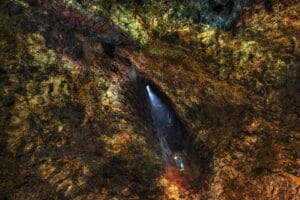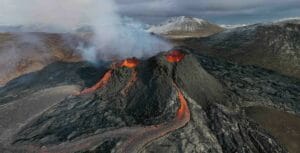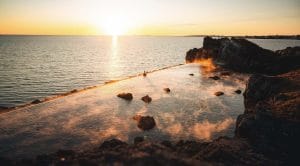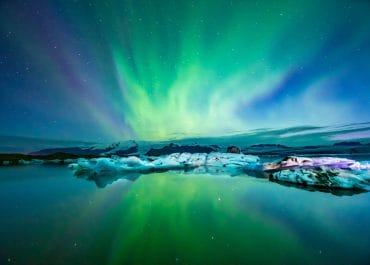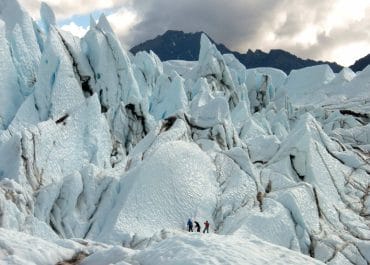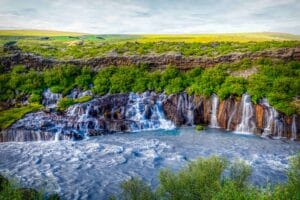It is that time of the year again when winter returns to its original glory in Iceland and most landscapes are covered in snow once again. December, without a doubt, is one of the coldest months that Iceland sees. Despite the gut-wrenching cold and the next to never-ending dark hours, December is anything but dreary. It is one of the months which sees the most celebratory occasions, like Christmas and New Year’s festivities. While the highlands roads are closed due to heavy snowfall, the place is still filled with plenty of things to do around the clock, both inside and outside the city and not to mention, it is one of those months when you can see Aurora Borealis as the actual beauty that it is.

Weather in Iceland in December
Temperature
The average temperature of Iceland in December ranges from -1°C to 4°C (34°F to 39°F). December can be seen as one of the coldest months in the country. Most parts of Iceland are extremely cold although the capital city remains a bit hotter as compared to other areas.
Daylight hours and Precipitation
There are only 4 – 4.5 hours of daylight in Iceland in December. Winter Solstice, the shortest day in Iceland, is only 4 hours and 7 minutes long. Winter Solstice falls from around 20th to 22nd December. It will occur on the 21st of December in the year 2020. The country gets an average of 97mm of precipitation in December which can come in any form from drizzle to heavy rainfall, snowfall, or blizzard.

Pros and Cons of Visiting Iceland
The festive spirit, the incoming winter season, and the authentic vibe of the land of fire and ice are what you will get to experience when you visit Iceland in December. Your heart will be filled with Christmas cheers and you will be feasting on not only incredible dishes but also the traditions of Iceland. Although, the temperature of Iceland is extremely cold in December and you may find out that some of the hot spots and activities are closed due to bad weather.
Best Self Drive Activities in Iceland in December
December Special Attractions of Iceland
Lava Caves

Like most of the touring activities and options, lava caving is also available whole year-round. While it is always an experience to remember, visiting lava caves in winters is especially gorgeous because of the beautiful ice sculptures formed inside of them. The porous lava rocks let the water seep through which freezes before it can reach the ground and hence from beautiful ice structures known as stalactites – structures that hang from the ceiling. Whatever amount of water reaches the ground freezes as soon as it touches the floor of the caves and forms structures known as stalagmites – structures that grow from the ground above. Some caves which are accessible for touring all year-round are Leiðarendi, Víðgelmir, and Raufarhólshellir (near Hveragerði). You pick one to visit as per the degree of challenge you want to face. For example, Leiðarendi is ideal for adventurers who like it when nature tackles with full force. This cave does not have any pathways or lights installed inside so you will have to crawl your way-out using flashlights and such. Víðgelmir, on the other hand, is ideal for those who prefer a bit of open space and less of a challenge.
Northern Lights

Come December and Northern Lights once again begin to shine bright for the most of the night. There are plenty of ways in which you can enjoy the gorgeous view of the northern lights – from the areas which are near to the city you are staying at, using a rental car to drive to remote locations or by booking a northern lights tour. While the first option seems like the easiest way around the cause, it also has some disadvantages such as undeniable light pollution. The next option of taking a self-drive tour in a four-wheeler, such as super jeep, is a fairly good one given the fact that you have a thorough knowledge of the routes and the roads. If you would like to maximize your chances of seeing the northern lights, book a tour with a local guide and travel with a northern light expert.
Diving and Snorkeling in December

Diving is much enjoyed in the relatively hotter season but it is equally popular in the winters. The most popular site for diving and snorkeling in Iceland is Silfra fissure spring which is located between two tectonic plates, North America and Eurasian plates. The fissure is located in Þingvellir National Park, which is a part of the famous Golden Circle route. The water of the spring stays at a stagnant temperature of 2°C throughout the year. The water in the spring is filtered through the porous lava rocks which makes it crystal clear and makes the visibility up to 100 meters under the water.
Glacier Hiking in December

Glacier hiking is back in full swing in December. Most of the glaciers are covered in snow and open for hiking in December. Skaftafell Nature Reserve is one of the most popular places in Iceland for hiking for Skaftafellsjökull glacier. The difficulty level is medium and the view from atop is spectacular. Perfect to trigger the dormant adventurer inside of you, these beautiful glaciers covered in electric blue ice are perfect to experience the thrill of coming one-to-one with nature in its crude form. Glacier hikes can be enjoyed as a solo activity or they can be combined with other activities that are closely related like snowmobiling, ice caving, visiting glacier lagoons, etc.
Snowmobiling

There is no way that you should miss out on snowmobiling when you plan your trip to the glaciers in Iceland. The thrill of glazing about the snow usually lasts an hour or so but it is a sure shot that this will be one of the most enjoyable experiences of your trip to Iceland in December. You can take a snowmobile as your transporting vehicle to the glaciers when you go hiking or you can choose to enjoy the ride as a wholly separate activity depending on your preference. While the winter protective equipment is provided by the operators, make sure you are wearing the right kind of thermal layers underneath. Snowmobiles come with a designated driver although a valid driving license is required if you want to drive yourself.
Go Sightseeing in Super Jeeps

Locations like golden circle, Jökulsárlón glacier lagoon, Snæfellsnes Peninsula, and the South Coast are the best place to go sightseeing in Iceland in December. While some roads and routes are closed due to heavy snowfall and bad weather conditions, these places remain accessible to tourists and can be visited by most types of vehicles. There are various long-running tour packages directed solely for the viewing of the highlands as the roads to the highlands are closed during the high winter season. The most comfortable way to get around these destinations is by booking one such tour with a local tour company.
Imagine Peace Tower

Imagine Peace Tower is a tribute to John Lennon from his wife Yoko Ono. It features “peace” written on the bottom in 24 different languages representing the message of harmony and unity. The ceremony of lighting the Imagine Peace Tower takes place on October 9th and is switched off on December 9th (birth and death date of John Lennon, respectively). You can simply catch a ferry ride to Viðey Island to watch the 4000-meter-high beam of light in person. If you happen to visit Iceland in late December then you get a second chance to see the lighting of Imagine Peace Tower. It is relit on December 21st, the day with the least number of daylight hours in the whole year, also known as Winter Solstice. The tower stays lit till the 31st of December.
Visit the Blue Lagoon

After you are done with a trip to the glaciers for hiking, snowmobiling, horse riding, and ice caving, kicking back some fatigue while submerged in the soothing hot waters of the Blue Lagoon is the only thing to do. The soothing hot water combined with the contrasting chilly weather outside is the ideal mixture that represents Iceland as the land of fire and Ice. Gulf streams running towards the country make the natural underground water hot (and boiling at some places) which creates countless relaxing pools and lagoons all over the place.
Árbæjarsafn Open Air Museum

Located in farmstead, Árbær, Árbæjarsafn Open Air Museum was built in 1957 to preserve the traditional heritage of Reykjavík. The open-air museum is a life-size portrayal of a historical village containing 20 different buildings. Visitors can observe the traditional church of Reykjavík, turf houses, and many other pre-historic attractions. The museum is situated right on the borders of Reykjavík and hence easily accessible to all travelers. While the Árbæjarsafn Open Air Museum represents the culture and tradition of Reykjavík, it is also well-equipped to present the holiday spirit in the traditional Icelandic ways. It features exhibitions on the ways prehistoric Icelanders from various backgrounds and families celebrated Christmas.
Best Day Tours to Take in Iceland in December

December Festivals in Iceland
Yule Lads’ Visits
Iceland has a hidden unique charm in all that it has and is. Whether the landscape, language, cuisine, or the festivals, Iceland strays a bit different from the rest of the world in every good way. One such eccentric attraction of this country is the Christmas folklore and traditions. Icelandic people celebrate the arrival of Yule Lads instead of Santa Claus, like the rest of the world. As the folklore goes, Yule Lads are the mischievous sons of the old evil ogress Gryla who find misbehaving kids and eat them. Yule Lads descend from their home in the mountains and visit the kids. The tradition has the Lads to leave small gifts for the good kids in their shoes that they leave outside their doors or hanging in the windows, while the mischievous ones get potatoes. Yule Lads’ visit lasts for 13 days and ends on the day of Christmas. It is one of the most awaited events of the year, especially by the children and wonderful decorations, and other preparations are made to welcome the Lads. The whole country is romanticized in the spirit of Jólin or Christmas.
Yule Lads’ Bath
Yule Lads is celebrated with the same kind of intensity as Santa Claus. The thirteen days preceding Christmas are the days of the Yule Lads. It is often said that the Yule Lads live in the mountains, but some people believe that Dimmuborgir lava fields is their home. Children often go out to Dimmuborgir near Lake Mývatn and take a dip in the Mývatn Nature Baths. Needless to mention, tourists are also welcome to join in the Icelandic Christmas spirit by visiting the Yule Lads and taking a bath with them in the lake.
Christmas Markets and Celebration
A white Christmas is not the only pleasure you will get if you spend it in Iceland. Icelandic Christmas is different from all, lasts longer than any other Christmas celebration in the world, and the preparations are all that more upscale and grander. Christmas trees are alight on the 4th Sunday before Christmas all across the country. The Great Christmas Tree is lit in the capital city at Austurvöllur. It is one of the most popular Christmas events as it also features the surfacing of the first Yule Lad. Restaurants serve their famous Christmas buffets and bars host several concerts in the spirit of the festival. Shops and markets stay open till 10 p.m. from December 15th to December 23rd. The town of Hafnarfjörður in greater Reykjavík is the place that is completely submerged in the Christmas spirit and probably displays all the traditional Christmas events and ceremonies that there are. It is the ideal place to head to if you want a genuine experience of Iceland’s traditional Christmas.
St. Þorlákur's Day
Observed in the honor of St. Þorlákur Þórhallsson, Iceland’s one and only Patron Saint, St. Þorlákur’s Day is celebrated all across Iceland with much enthusiasm and positivity. Icelanders eat fermented Skate, a type of traditional fish dish with intense aromatic attributes. Cooked domestically in all households, the markets are packed till 11 pm by locals doing some last-minute shopping for the ingredients. You can easily spot this traditional dish being prepared in many restaurants. Order a serving and join in with the traditional celebrations with the locals.
New Year's Eve 10 km Run
Held by track and field club ÍR, New Year’s Eve 10 km run is one of the most popular sporting events of the year. Harpa concert hall is prepared to facilitate the racer and attend to all their needs before the race starts. Waves of people come and participate in the run and flaunt various costumes. The prizes are reserved for the best costumes among the runners. The race starts at Sæbraut near the Harpa concert halls and finishes at the same place after covering a long-stretched route towards the ocean to the east past the Sólfar sculpture. Anyone and everyone can join the race by simple online registration. Not only do you get to enjoy with the locals, relax in the majestic Harpa concert hall and enjoy the different landscapes, but this race also gives you an experience that is immeasurable in terms of thrill and excitement.
New Year’s Celebration

As the month approaches its end, Iceland prepares for New Year’s celebration on December 31st. the capital city of Reykjavík is one of the liveliest places in the country during this time and is sure to give you a fair taste of New Year’s celebration. The evening of 31st is filled with delicious food, banter, and laughter all across Iceland as people enjoy the night with family and friends. Locals come down to the street to watch the massive firework display let off unofficially by the citizens. While you can enjoy this from pretty much any place in Reykjavík, places like Hallgrímskirkja (a large church that overlooks the city) and Perlan are two of the best places to get a proper view of the fireworks.
Best Multi Day Tours to Take in Iceland in December

Stack the Backpack – The List of Essentials
You need to be fully prepared for the challenges that may come your way in terms of weather and necessities when traveling away from home. Following is a complete list of essentials that you will need when traveling to Iceland in December.
Outwear:
- Waterproof and windproof winter pants and jackets
- Insulated jacket for extremely low temperatures
- Warm caps and hats
- Scarf, buff as neck shield against wind
- Windproof warm Gloves
Clothes to Layer Up:
- Thermal Innerwear to stay warm when out
- Fleece and woolen layers in the form of cardigans and sweaters
- Full-sleeved cotton shirts/t-shirts
- Comfortable warmers or leggings
- Jeans/Pants for festivals and concerts
- Swimsuit
Footwear:
- Waterproof hiking boots
- Casual, walking and sport shoes
- Flip Flops
- Heavy warm socks
- Ice cleats
Additional Important Picks
- Moisturizer
- Toiletries – like soap, shampoo, bath towels, quick-drying towels, etc.
- Phones, chargers, power banks, batteries, flashlights, and travel adapters
- Rain cover and windshield for eyes
- Camera and required gear
- Prescription medicines and Over the Counter Medicines for the trip

We hope this article about Iceland in December will help you figure out if it’s the best month for you to visit Iceland or not.
We would love to hear your thoughts. Tell us about your tips and tricks to when it comes to planning a trip to Iceland.
It would be perfect if you let us know about your favorite locations from your trip. It’s even better if they are hidden gems that you would like to share with the rest of us.
Leave your comments and questions below and we will happily answer all of them

